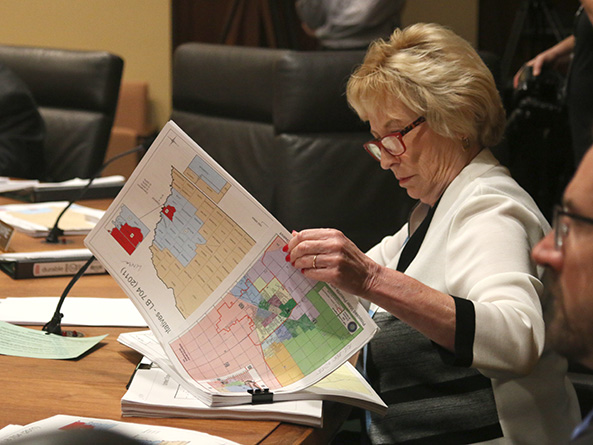Second redistricting hearing focuses on congressional districts, process
The Redistricting Committee held the second of three public hearings Sept. 15 on proposed plans to redraw congressional, legislative and other political district boundaries.
Several senators testified, describing how the proposed congressional and legislative redistricting plans would affect their districts.
Sen. Mark Kolterman of Seward opposed Elkhorn Sen. Lou Ann Linehan’s proposal in LB3, which would merge his District 24 with District 23 and create a new District 24 in Sarpy County. He instead supported an alternative map, proposed by Sen. Justin Wayne of Omaha in LB4, which would keep York and Seward counties together in District 24.
Kolterman said his is one of 12 rural legislative districts whose populations have grown since the 2010 census. Lawmakers easily could preserve the district’s core by making relatively minor boundary changes, he said.
“I’m willing to compromise,” Kolterman said, “but don’t tear my district apart.”
Sterling Sen. Julie Slama supported Linehan’s congressional redistricting plan outlined in LB1 because it would keep Otoe County, which is located in Slama’s legislative District 1, wholly within the 3rd Congressional District and would split Douglas County between the 1st and 2nd Districts.
Wayne’s LB2 instead would split Otoe County between the 1st Congressional District and the 3rd District and leave Douglas County wholly within the 2nd District.
Slama said it would make more sense to split Douglas County, which she said comprises many distinct communities of interest, rather than “cohesive” rural counties like Otoe that have primarily agricultural interests and where residents have similar socioeconomic and educational backgrounds.
Sen. Mike Moser of Columbus opposed Wayne’s congressional plan in LB2 because it would move Platte County, located in Moser’s legislative District 22, from the 1st Congressional District to the 3rd District. He said Platte County, which is home to a large number of manufacturers, has more in common with the 1st District than the 3rd.
When redrawing legislative district boundaries, Moser said, lawmakers should “take advantage” of guidelines that allow them to consider plans in which a district’s population deviates from the ideal population by up to 5 percent. He said this approach would allow the Legislature to retain more rural districts despite population loss in those areas.
Gavin Geis of Common Cause Nebraska said senators “risk losing the thread” of the redistricting process if they draw maps with any goal other than equalizing population among districts.
He said the U.S. Supreme Court has ruled that weighing votes differently according to where residents happen to live is discriminatory and that group interests or district area alone do not justify deviations from the one-person, one-vote principle.
“We should be following the data,” Geis said. “We should be making sure that every Nebraskan’s vote has equal power.”
Danielle Conrad of the ACLU of Nebraska said compressing the redistricting process into only a few weeks prioritizes the interests of candidates and incumbents — who soon must file for election or reelection in their districts — rather than the voters whose rights the process is intended to protect.
She suggested lawmakers consider extending the special session to give Nebraskans more time to analyze proposed redistricting plans, which were released less than a week ago, and provide more ways for the public to participate in the process.
“We need more time to digest that [information] in a thoughtful and deliberate way,” Conrad said. “We need more time to have meaningful public participation.”
The committee took no immediate action on the redistricting proposals.


